
F.W. Kent Park 7/2/2010
| Classification Hierarchy | |
| Kingdom | Plantae |
| Subkingdom | Tracheophyta |
| Superdivision | Spermatophyta |
| Division | Magnoliophyta |
| Class | Magnoliopsida |
| Subclass | Rosidae |
| Order | Apiales |
| Family | Apiaceae |
| Genus | Daucus |
| Species | Daucus carota |

F.W. Kent Park 7/2/2010
Scientific Name:
Daucus carota[Lat. dauci - carrot; carot - flesh color (reddish)]
Common Name:Queen Anne's lace; wild carrot.
Origin:Alien (Europe, Asia)
Habitat:disturbed areas, roadsides, prairie edges.
Notes:
D. carotais a biennial weedy species that some states (including Iowa) have listed as invasive. In Iowa it is considered a
secondary noxious weed. Some people love it and some people hate it. School children like to place the stem of a cut flower head into a glass with food coloring to watch the flowers pick up the color. The plant has a history as an aid to birth control and in sensitive individuals the leaves can cause dermatitis, for this reason the plant is sometimes called
poisonous. The garden carrot is one of several
varieties cultivated from
D. carota. Keep in mind that
D. carota can be confused with either of two very toxic species (
Conium maculatum
and
Circuta maculata
) which are also in the carrot family (Apiaceae). If you decide to munch on a wild plant with double umbels and white flowers, you may be betting your life on your taxonomic skills.
Additional references:
1,
2,
3,
4,
5,
6,
7,
8,
9,
10.
Flowers: July; small white, secondary umbels, often a colored flower at the center; large slender three-pointed tips on involucral bracts beneath the primary umbel, unvolcel bracts under umbellets; fruit is a bicarpel schizocarp with spiny ridges.
Leaves: first year - a rosette of 2 or 3 pinnate deeply incised leaves (like garden carrots), second year - a few (cauline) leaves are attached to the flower bearing stems.
Stems: stems are hairy, up to 31/2 feet high, and terminate in a compound umbel inflorescence.
Glossary:
Botanical Terms pdf
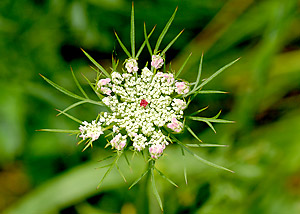
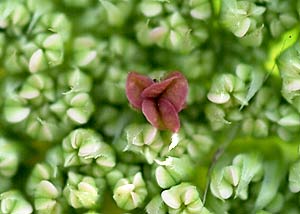
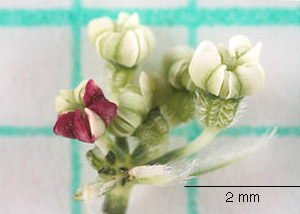
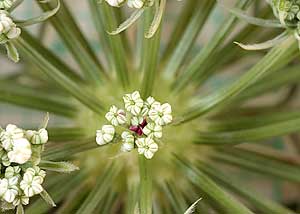


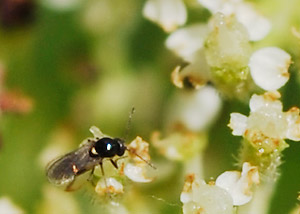
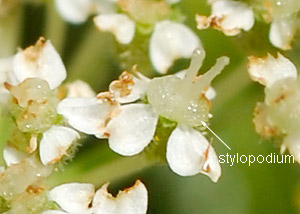
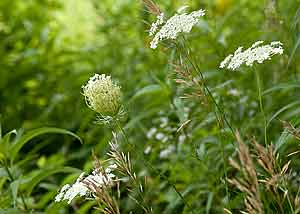
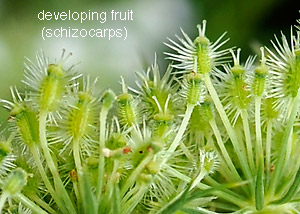
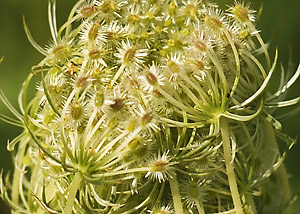
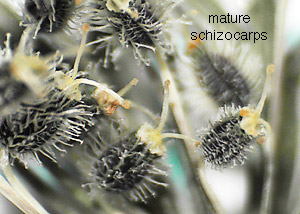

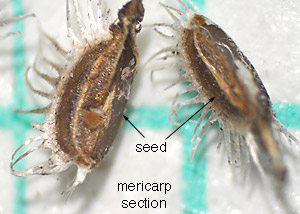
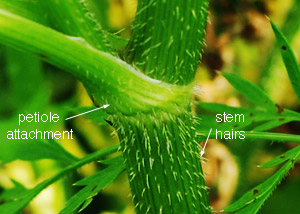

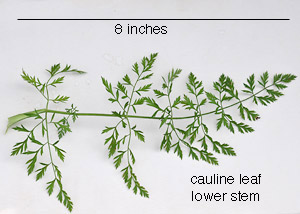
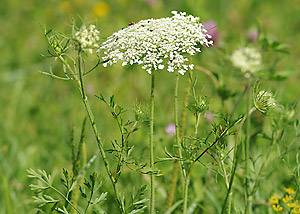


Comments:
Daucus carota, commonly called "Queen Anne's lace" or "wild carrot" is ancestral to the modern garden carrot. The leaves, seeds, flowers, and even the smell are similar to those of the garden carrot. The tap root however, is usually smaller, paler, and sometimes woodier than the tastier garden carrot.
It is important to know the difference between Queen Anne's lace (Daucus) and the two toxic hemlocks (Conium and
Cicuta) with which it is sometimes confused. The two hemlocks usually have purple markings on the stems and tend to be bushier and taller and the white umbels more loosely distributed around the top third of the bush.
Daucus, by comparison, is usually shorter (~ 3 1/2 feet) and its dense compound, often flat, umbel sits atop a long slender hairy green stem. In our area at least,
Conium is the first to flower. It usually appears in disturbed areas with moist or mesic conditions and can often be found in large stands along railroad tracks. Next to flower is
Cicuta and after that
Daucus.
Cicuta prefers a wetter soil and has broader leaflets than does
Daucus.
Daucus prefers mesic to dry conditions and can sometimes be found in the same area as
Conium.
Conium is a larger and bushier plant usually between 5 and 9 feet tall. It is losing its white flower petals about the time that
Daucus is beginning to bloom.
Daucus is weedy and can form large colonies.
There are several features that are distinctive about
Daucus. Sometimes there is a colored flower in the middle of the umbel. Beneath the primary umbel are large narrow bracts that are triple pointed at the terminus. The umbels and unbellets curve into a ball while the fruits are maturing. Some people call
Daucus the bird's nest plant because these folded umbels can look like a nest as the plant ages. The stems of
Daucus are hairy (to varying degrees) while the stems of both hemlocks tend to be smooth. The fruits (often called seeds) are schizocarps with ridges and prominent spines. The fruits of both hemlocks are also schizocarps but they are rounder and lack the spines. The schizocarps from all three plants split (dehisce) to produce two single seeded mericarps which are the propagules from which new plants are produced.